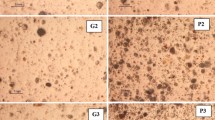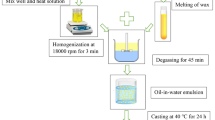Abstract
The incorporation of lipids into hydrophilic protein films allows the modification of their barrier properties, improving its commercial application as preservation medium on different foods. The main objective of this study was to develop films from Whey Protein Isolate (WPI) together with saturated and unsaturated fatty acids and to determine the effect of concentration and unsaturation degree on surface tension of the coating solution and on water vapor permeability (WVP), mechanical properties (tensile strength and elongation at break), and opacity, of the films. The results obtained showed that surface tension was significantly decreased by adding unsaturated fatty acids (oleic and linoleic acid), whereas the greatest effect on WVP reduction was achieved with stearic acid. The addition of stearic acid resulted in a decrease of elongation and an increase of tension strength; however unsaturated fatty acid content did not modify the elongation and slightly reduce a tensile strength.





Similar content being viewed by others
References
Krochta JM (1997) Edible protein films and coatings. In: Damodaran S, Paraf A(eds) Food proteins and their applications. Marcel Dekker: New York
Cagri A, Usturol Z, Ryser ET (2001) Antimicrobial, mechanical, and moisture barrier properties of low pH whey protein-based edible films containing p-aminobenzoic or sorbic acids. Food Microbiol Safety 66(6):865–870
Greener D, Fennema O (1994) Edible films and coatings: characteristics, formation, definitions and testing methods. In: Krochta JM, Baldwin E, Nisperos-Carriedo M (eds) Edible coating and films to improve food quality. Lancaster, PA: Technomic Publication Co., pp. 1–24
Pérez-Gago MB, Krochta JM (2001) Lipid particle size effect on water vapor permeability and mechanical properties of whey protein/beeswax emulsion films. J Agric Food Chem 49(2):996–1002
McHugh TH, Krochta JM (1994) Plasticited whey protein edible films: water vapor permeability properties. J Food Sci 59(2):416–423
Mahmoud R, Savello PA (1992) Mechanical properties of and water vapor transferability through whey protein films. J Dairy Sci 75:942–946
Sothornvit R, Krochta JM (2000) Oxygen permeability and mechanical properties of films from hydrolyzed whey protein. J Agric Food Chem 48:3913–1916
Pérez-Gago MB, Krochta JM (1999) Water vapor permeability of whey protein emulsion films as affected by pH. J Food Sci 64:695–698
McHugh TH, Khochta JM (1994) Water vapor permeability properties of edible whey protein–lipid emulsion films. JAOCS 71(3):307–312
Tanaka M, Ishizaki S, Suzuki T Takai R (2001) Water vapor permeability of edible films prepared from fish water soluble proteins as affected by lipid type. J Tokyo Univ Fisheries 87:31–37
Shellhammer TH, Krochta JM (1997) Whey protein emulsion film performance: effect of lipid type and amount. J Food Sci 62:390–394
Fennema R (1996) Food chemistry, 3rd ed. New York Basel Hong Kong: Marcel Dekker, pp. 226–228
Rhim J, Wu Y, Weller CL, Schnepf M (1999) Physical characteristics of emulsified soy protein–fatty acid composite films. Sciences des Aliments 19:57–71
Yang L,Paulson AT (2000) Effect of lipids on mechanical and moisture barrier properties of edible gellan film. Food Res Int 33:571–578
McHugh TH, Avena-Bustillos RJ, Krochta JM (1993) Hydrophilic edible films: modified procedure for water vapor permeability and explanation of thickness effects. J Food Sci 58:899–903
Kleen D, Padua G, Engeseth N (2002) Stabilization of lipids in a biodegradable zein-oleate film by incorporation of antioxidants. Cereal Chem 79(5):687–694
Rakotonirainy AM, Padua GW (2001) Effects of lamination and coating with drying oils on tensile and barrier properties of zein films. J Agric Food Chem 49:2860–2863
Kamper SL, Fennema O (1984) Water vapor permeability of edible, fatty acid, bilayer films. J Food Sci 49:1482–1485
Morillon V, Debeaufort F, Blond G, Capelle M, Voilley A (2002) Factors affecting the moisture permeability of lipid-based edible films: a review. Crit Rev Food Sci Nutr 42(1):67–89
Acknowledgements
The authors thank the Basque Government by the grant of PhD Formation Programme in Technological Centres promoted by the Department of Industry, Trade and Tourism and the Department of Education, University and Research.
Author information
Authors and Affiliations
Corresponding author
Rights and permissions
About this article
Cite this article
Fernández, L., de Apodaca, E., Cebrián, M. et al. Effect of the unsaturation degree and concentration of fatty acids on the properties of WPI-based edible films. Eur Food Res Technol 224, 415–420 (2007). https://doi.org/10.1007/s00217-006-0305-1
Received:
Revised:
Accepted:
Published:
Issue Date:
DOI: https://doi.org/10.1007/s00217-006-0305-1




